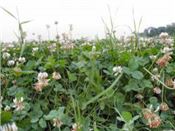Spring Pastures Are Too High In Protein

URBANA, ILL.
After hauling feed to cows all winter, there is no better thing than turning cows out to spring pastures. However, spring pastures are very lush and high in protein. These factors can ultimately contribute to poorer performance and slower breed-back in some cases, explained a University of Illinois Extension beef educator.
“After experiencing slower breed-up in the university herd and hearing many similar complaints from Illinois cattlemen who calve in late winter, we decided to investigate supplementing cows with a dry, low-protein mix to see if performance improved,” said Travis Meteer.
Pastures at the Orr Research Center are composed of endophyte-infected fescue, red clover, orchard grass, and white clover. Meteer said that samples from the pastures showed that crude protein (CP) was around 25 percent in early May. CP content declines as expected as the forage matures, however, measurements in 2013 and 2014 show levels could be in excess for approximately 20 days.
While protein levels are high, the fiber components of the plant, acid detergent fiber (ADF), and neutral detergent fiber (NDF) are low. “This combination lends to loose stools and high passage rates,” Meteer said.
Despite seeing no differences in cow body weight or body condition score either year of the trial, Meteer said he saw a numerical increase of 22 percent in first service conception rates in 2013.
“In 2014, we saw a 14 percent increase. It is evident that cows that received the dry, low-protein supplement were more apt to breed early in the season, despite no differences in overall conception rates,” he said. “Logically, as the grass matures, it decreases in CP and increases in fiber, and the cows breed, but they breed later in the season.”
In 2014, Meteer and his team took blood samples from the cows to look at the blood urea nitrogen (BUN) levels. Cows that received no supplement, only green grass, tended to have elevated BUN levels after being turned out to pasture.
Observing cows panting, crowding, or showing signs of heat stress, despite moderate temperatures, is common in cows that are consuming excess protein, Meteer said. “You can check urine pH as well. If the pH is above 7, the pasture is providing a diet that has excess protein. The obvious observation is the consistency of the manure. Loose, runny manure is a sign of excess protein,” he cautioned.
Supplementing cows on lush spring pasture that is too high in protein may be necessary to avoid losses in performance. Rotating cows rapidly through paddocks, only allowing them to consume the top one-third of the plant, can help, Meteer said.
“Cows calving from mid-February to mid-March will be the most likely to experience trouble re-breeding as the lush spring pasture coincides with their breeding season. Cows calving earlier are likely bred while still receiving harvested feeds, and cows calving later will breed on more mature forage,” he added.
“Providing a dry, low-protein supplement that is palatable will help balance protein excess in the rumen and contribute to optimal performance,” Meteer said. ∆